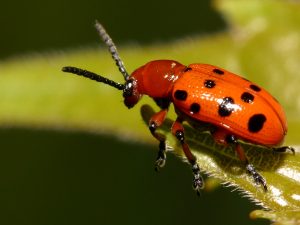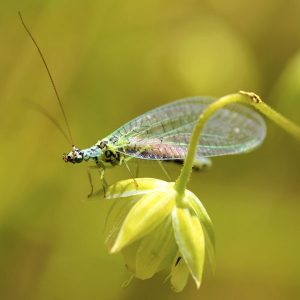Asparagus Beetle (Crioceris asparagi) is the most common garden pest that damages both garden variety and wild plants. Originally a European species, it has spread across the United States, primarily damaging Asparagus plants.
The full-grown adult Asparagus Beetle of ¼ inches long are metallic blue to black with creamy yellow spots and reddish margins on their wing covers. The other variety of Asparagus Beetle, known as Spotted Asparagus Beetle is orange in color with 6 black spots on each wing cover and often mistaken with the red spotted ladybirds.
 The dark gray larvae of the asparagus beetle with a black head are 1/3 inches long with slug-like appearance. Eggs of the asparagus beetle that are usually found on the spear, are oval shaped, dark brown and about 1.5mm long. These are found in groups of 3 to 8 oriented in a row and attached to one end to the host plant.
The dark gray larvae of the asparagus beetle with a black head are 1/3 inches long with slug-like appearance. Eggs of the asparagus beetle that are usually found on the spear, are oval shaped, dark brown and about 1.5mm long. These are found in groups of 3 to 8 oriented in a row and attached to one end to the host plant.
Damage caused by Asparagus Beetles
If effective asparagus beetle control is not implemented, the adults and the larvae will feed on the tips and spears of the plant. The “Frass” or the excrement from both larvae and adults, stain the spear and oviposition on the spears can present as deformities of the plants. The presence of the Asparagus Beetle is determined with the twisted Asparagus heads usually known as “Sheperd’s Crook Syndrome” and the brown spear tips. The beetle infestation can limit the amount of nutrients in plants and cause them to procreate fewer and less vigorous spears.
Damage Control
The sighting of one single adult of either the common Asparagus Beetle or Spotted Asparagus Beetle should be an alarming warning of the infestation that should provoke you to execute a desired asparagus beetle control.
-
Basic control methods for mild infestations
- Eliminating adults as they emerge from the soil and climb up the plants can control worse outbreaks later.

Spotted asparagus beetle
Begin inspection of plants in April and early May as soon as the asparagus spears sprout off the ground.
- Handpick the adults and larvae from the infested plants and drop them into a container of soapy water and extract spears of eggs when you harvest.
- You can brush the infested plants with a broom and drop the larvae onto the ground thus making it impossible for them to reclaim the plant. This method of asparagus beetle control should be used for a small garden or on less number of plants.
-
Cultural Control
- An early harvest orchestrated to end the lifespan of the beetle will effectively control the insect. The adult beetles usually take interest in asparagus with foliage. Inspect for adult insects, larvae, and eggs during harvest. The growers can leave a portion of the crop unharvested as a decoy for the beetles to multiply which later needs to be destroyed.
- Once the crops are harvested, turn the soil over around the plants to disturb the pupating larvae and accomplish a successful asparagus beetle control. Ensure you are attentive of the margins around your asparagus patch since the larvae overwinter close to the areas where asparagus grows.
-
Organic/ Biological control
- If you are planning on implementing organic asparagus beetle control methods, spray or dust the plant or treat the adult insects directly with botanical insecticides after the initial sighting of the insects.
- Insects, especially ladybugs and lacewing, will consume the eggs and small larvae while birds will pick both adults and larvae from plants and the ground. Ensure your yard is free of pesticides and welcoming of birds and other beneficial insects.
- The tiny parasitic wasp Tetrastichus asparagi Crawford, lays its eggs on the larval stage of the asparagus beetle, destroying it from the inside out. The parasite is not commercially available and is naturally attracted to asparagus patches.

- Chemical Control
- Treat the infestation with a registered insecticide, when the beetles begin to lay eggs or when the larvae are feeding on the foliage. Since the asparagus spears are sometimes harvested daily, it is important to use an insecticide with the minimum residue. Ensure you follow the instructions to wait the prescribed time until the next harvest, once the insecticides are applied for asparagus beetle control.
- Treat the crops with a registered insecticide in the fall to reduce the beetle population before they pupate thus reducing the number of beetles the following spring.
- These insecticides are available at stores and online. However, it is precautionary to research and consult a pest control professional before usage of these chemical-based products.

No Comments